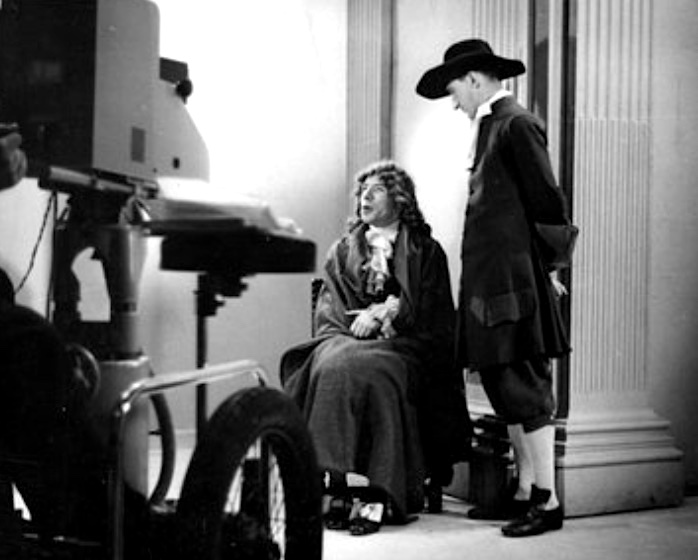OTD in early British television: 4 April 1938

John Wyver writes: Afternoon transmissions on Monday 4 April 1938 were mostly taken up by a 45-minute ‘feature’ about Sir Christopher Wren. This dramatised presentation was scripted by playwright Christine Hahlo, whose only other credit I can find is Poet’s Licence presented in the West End in 1932. William Devlin took the part of the architect, Robert Rendel was John Evelyn, Rex Walters played Charles II, and Samuel Pepys was incarnated by Ivor Barnard.
Producer Eric Crozier had mounted the earlier ‘feature’ Turn Around in September 1937, which combined dramatised studio sequences with a modest amount of location filming on an ocean-going luxury liner. Wren of St Paul’s applied the approach to a historical subject.
Radio Times‘ well-informed diarist ‘The Scanner” carried an interesting preview:
On Monday and Saturday Wren of St. Paul’s will be televised, the first really ambitious attempt made at Alexandra Palace to present something corresponding to the feature programme in sound broadcasting.
The difficulties of this kind of show in television are many. Eric Crozier, producer of the Wren programme, thinks that the use of a narrator is to be avoided if possible. As for the technique of using a team of marrators with varying voices, this, in the opinion of many people, is a bad thing in sound radio; in television it would be ten times worse.
Wren of St. Paul’s is an attempt to sketch something of the period just after the Great Fire. London was rebuilt, and from the ruins of old St. Paul’s rose the cathedral we have today. Wren’s designs for the new cathedral were rejected time and time again by the Commissioners, despite the support of Charles II.
Programmes with biographical material such as this are likely to be developed in television on entirely different grounds from sound broadcasting.
Developed from 1928 onwards, radio features, as Paddy Scannell and David Cardiff detailed in their invaluable A Social History of British Broadcasting, volume 1, ‘combined words and music to produce an artistic effect which could not have been produced by either separately… the feature programme arranged its material into original forms that exploited the potential of the medium.’
Producer Lance Sieveking was an influential early exponent, but his modernist experiments found little long-term favour, and in the mid-1930s the social documentaries produced as features by Laurence Gilliam using actuality sound recorded on location proved to be singularly more influential. Beginning with ‘Opping ‘Oliday in 1934, about the hop harvest in Kent, Gilliam made a series of notable broadcasts, including a small number of programmes dedicated to the workings of public utilities.
But the features team in London somewhat lost its way in the lead-up to the war, and the most innovative and progressive radio features were instead made for BBC North Region in Manchester under Archie Harding. A unit that included writer Geoffrey Bridson, producer Olive Shapley and theatre activist Joan Littlewood pioneered vivid techniques that included working-class miners speaking spontaneously for the 1938 broadcast Coal.
Interwar television brought forth nothing directly comparable, although in addition to Eric Crozier’s productions, producer Moultrie Kelsall collaborated with a group of Scots including actor Andrew Cruickshank (later Doctor Cameron in the BBC television series Dr Finlay’s Casebook, 1962-71) to devise two innovative television features.
Stands Scotland…?, shown on for St Andrew’s Day 1937, was about that country’s proud tradition, and in the summer of 1938 this was followed by Exhibition: A Panorama – Paris 1797- Glasgow 1938. Mounted to mark that year’s Empire Exhibition, the latter combined music, songs, sketches and film montages to trace a story from just before the first National Industrial Exposition in France to the present day.
Irish producer Denis Johnston also contributed to the emerging form of the television feature, first in February 1939 when wrote and produced Death at Newtownstewart, a reconstruction of a murder trial from the 1870s. Later in the year, Johnston refined his techniques for The Parnell Commission, dramatising the proceedings of the 1888-89 judicial inquiry into allegations of criminal activity, ultimately found to be false, by the Irish parliamentarian Charles Parnell.
Confined largely to the studio, these early programmes can be seen in retrospect as among the first contributions to the tradition of the television documentary.
Leave a Reply